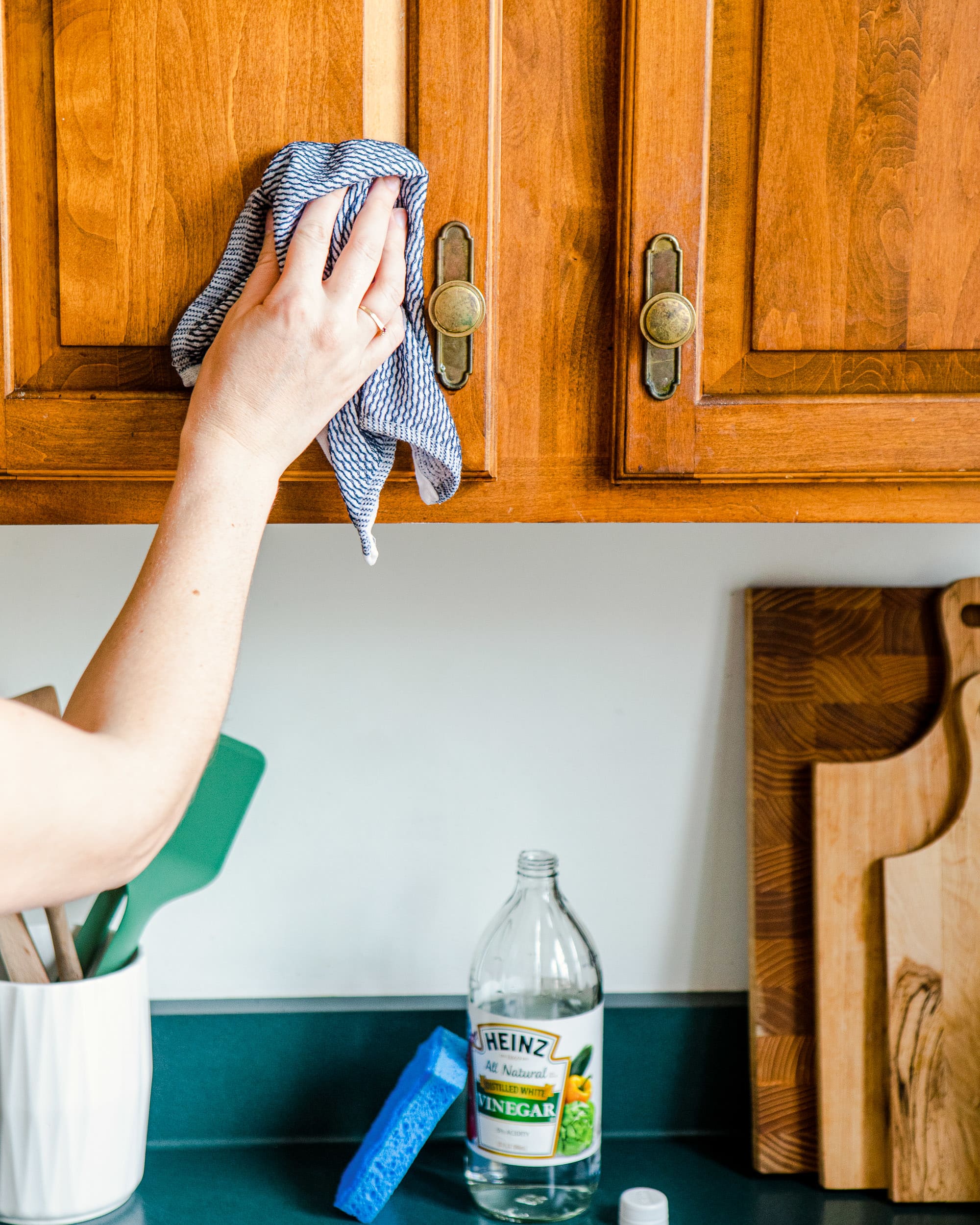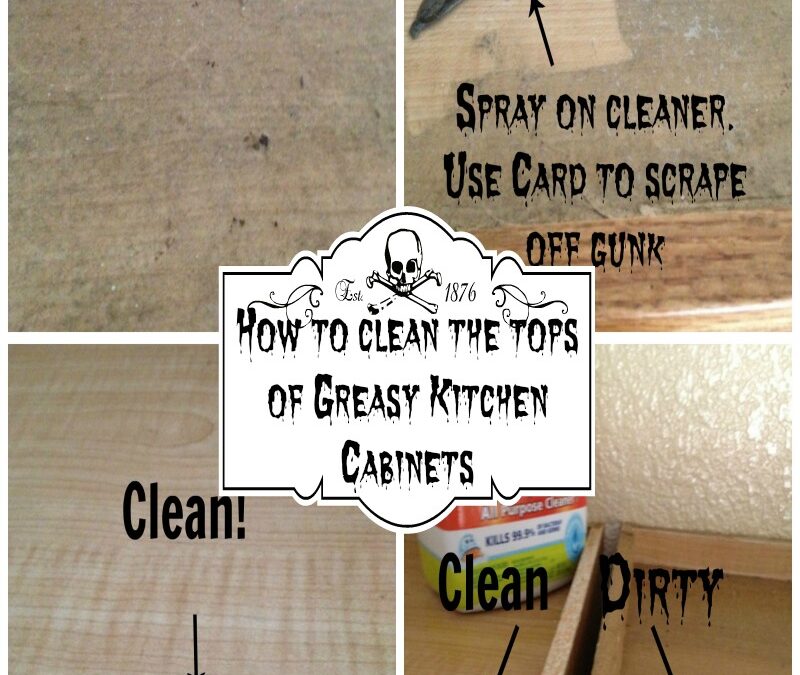Have you ever glanced at your kitchen cabinets and noticed a stubborn, greasy film that just won’t budge? You’re not alone.
Greasy kitchen cabinets are a common issue that many of us face, turning our cooking spaces from vibrant and inviting into dull and unappealing. But here’s the catch: finding the right solution doesn’t have to be a daunting task. Imagine a world where your cabinets gleam with a fresh, clean shine, making your kitchen feel like the heart of your home again.
Curious to discover what truly cleans greasy kitchen cabinets and why some solutions work better than others? You’re about to uncover the secrets that will transform your kitchen, making it a place you’ll love to show off. Keep reading to learn how you can easily restore the sparkle to your cabinets with techniques that really work.
Common Causes Of Greasy Cabinets
Greasy kitchen cabinets can be a common headache for anyone who enjoys cooking. It’s easy for them to become a magnet for grime and dirt, leaving you with a mess that seems impossible to clean. But have you ever stopped to wonder what causes this sticky situation in the first place? Understanding the root of the problem is crucial in tackling it effectively.
Cooking Oils And Fats
Every time you fry something, tiny oil particles disperse and cling to surfaces. These particles gradually build up, creating a thick, greasy film. Even using an exhaust fan doesn’t entirely prevent this from happening.
Steam And Moisture
Boiling water and steaming veggies release moisture into the air. This moisture can mix with airborne grease, causing it to adhere more strongly to cabinets. This combination makes cleaning a real challenge.
Fingerprints And Touches
Every time you reach for a spice or open a cabinet, your fingers leave behind oils and dirt. These marks add up over time, especially in busy kitchens. It’s surprising how much residue can build up just from daily use.
Poor Ventilation
Not all kitchens have adequate ventilation. Without proper air circulation, grease particles linger and settle on surfaces. This can be particularly problematic in smaller spaces or apartments.
Neglecting Regular Cleaning
Skipping routine cleaning sessions allows grease to accumulate. The longer it sits, the tougher it becomes to remove. A quick wipe-down after cooking can prevent this buildup.
Have you noticed your cabinets getting greasier over time? It’s likely due to these common causes. By addressing them, you can maintain a cleaner kitchen environment with less effort.
Choosing The Right Cleaning Products
Choosing the right cleaning products can effectively tackle greasy kitchen cabinets. Mild dish soap mixed with warm water works wonders. For stubborn grease, a mixture of vinegar and water can help break it down. Regular cleaning prevents buildup and keeps kitchen cabinets looking fresh and clean.
Cleaning greasy kitchen cabinets can be daunting, but choosing the right cleaning products makes all the difference. It’s not just about wiping away the grime; it’s about finding what works best for your cabinets’ material and your lifestyle. Whether you lean towards eco-friendly options or prefer the efficiency of store-bought solutions, understanding your choices can save you time and effort.Natural Cleaners
Natural cleaners are perfect for those who want a safer and more environmentally friendly option. Ingredients like vinegar, baking soda, and lemon juice are effective against grease and gentle on surfaces. I once used a simple mixture of equal parts vinegar and water to tackle the sticky residue on my kitchen cabinets. This solution not only cleaned the grease but also left a fresh scent. To boost the cleaning power, try adding a few drops of lemon essential oil. Do you want to avoid harsh chemicals around your family or pets? Natural cleaners offer peace of mind while still getting the job done.Commercial Cleaners
Commercial cleaners are designed for tough jobs and can quickly cut through layers of grease. They often contain powerful agents that dissolve grime, making them a go-to for many households. I once faced a stubborn grease stain that wouldn’t budge with natural cleaners, so I reached for a well-known commercial brand. It worked like a charm, leaving my cabinets spotless. However, always check the label for instructions to avoid damaging your cabinet finish. Are you dealing with years of built-up grease? Commercial cleaners might be the practical choice for achieving a deep clean. Both natural and commercial cleaners have their place in your cleaning toolkit. Have you experimented with different products to find what suits your needs best?Essential Cleaning Tools
Greasy kitchen cabinets need tools like degreasers, microfiber cloths, and baking soda. These items effectively remove stubborn residue and restore shine. Regular cleaning prevents buildup and keeps cabinets looking fresh.
Cleaning greasy kitchen cabinets can be a daunting task, but with the right tools, it becomes manageable and even satisfying. Essential cleaning tools are your arsenal against stubborn grease stains that have built up over time. You might be surprised to find that you already have some of these tools in your home, and if not, they are easy to acquire. Let’s dive into what you need to make your cabinets sparkle again.Microfiber Cloths
Microfiber cloths are a game-changer when it comes to cleaning greasy surfaces. Unlike regular towels, they trap dirt and grease without scratching the surface. Have you ever tried to clean with paper towels only to end up with lint everywhere? Microfiber cloths eliminate that mess, leaving surfaces clean and polished.Soft-bristle Brush
A soft-bristle brush is perfect for tackling those stubborn grease spots in cabinet corners and crevices. It’s gentle enough not to damage the wood but effective in scrubbing away grime. Imagine reaching those tricky spots with ease and watching the dirt vanish. Wouldn’t it be satisfying to see the transformation?Dish Soap
Dish soap is not just for dishes. It’s a powerful degreaser when mixed with warm water. Have you noticed how easily it cuts through the grease on your plates? The same principle applies to your cabinets. Use a mixture of dish soap and water to wipe down surfaces, and watch the grease melt away.White Vinegar
White vinegar is a natural cleaning agent that can tackle grease without harsh chemicals. If you’re looking for a more eco-friendly option, this is it. You might remember your grandmother using vinegar for cleaning, and she was onto something. Its acidity breaks down grease effectively.Baking Soda
Baking soda is another natural cleaner that works wonders on greasy cabinets. It acts as a mild abrasive, perfect for scrubbing away stubborn spots. Have you ever used baking soda to clean your stovetop? Its effectiveness there is mirrored in your cabinet cleaning efforts.Spray Bottle
A spray bottle makes applying your cleaning solution easy and efficient. Fill it with your preferred mixture—whether it’s soap and water, vinegar, or a baking soda paste—and spray directly onto the cabinets. It’s a simple tool that can make a big difference in your cleaning routine. Do you have these tools at your disposal? If not, they’re easy to find and won’t break the bank. Armed with these essentials, you’re ready to tackle even the toughest grease stains. Are you prepared to see the shine return to your kitchen cabinets?
Credit: www.thekitchn.com
Step-by-step Cleaning Process
Greasy kitchen cabinets can make your kitchen look untidy. A step-by-step cleaning process can bring back their shine. Follow these easy steps to clean your cabinets effectively. Keep your kitchen looking fresh and clean.
Preparation And Safety Tips
Before starting, gather all necessary cleaning supplies. Use mild dish soap, warm water, and a clean cloth. Wear gloves to protect your hands. Ensure proper ventilation in the kitchen. Open windows or use a fan to circulate air. Remove all items from the cabinets. This makes cleaning easier and more thorough.
Cleaning Techniques
Mix a few drops of dish soap with warm water. Dip a clean cloth into the soapy water. Wring out the cloth to avoid excess water. Wipe the cabinet surfaces gently in circular motions. Focus on areas with heavy grease buildup. Use a toothbrush for corners and edges. Rinse the cloth often to remove dirt.
Drying And Finishing Touches
Use a dry cloth to remove moisture. Ensure all cabinet surfaces are thoroughly dried. This prevents water spots and streaks. For a polished look, apply a small amount of wood polish. Buff the surfaces with a soft cloth. Replace all items in the cabinets. Enjoy your clean and fresh-looking kitchen.
Maintaining Clean Cabinets
Maintaining clean cabinets in your kitchen is essential. Greasy kitchen cabinets can be a headache. They spoil the look of your kitchen. Regular cleaning ensures cabinets remain spotless. It also extends their lifespan. Let’s explore how to keep them clean with a few strategies.
Regular Cleaning Schedule
Setting up a cleaning schedule is crucial. Clean cabinets once a week. Use a mixture of warm water and mild soap. This removes dirt and grease. Wipe with a soft cloth. Dry them immediately to prevent water spots.
For stubborn grease, try vinegar. Mix equal parts of vinegar and water. Spray on the cabinets. Let it sit for a few minutes. Wipe clean with a dry cloth. Vinegar cuts through grease effectively.
Preventive Measures
Preventive measures help keep cabinets clean longer. Install a quality range hood. It reduces grease buildup. Ensure good ventilation in the kitchen. This minimizes humidity, reducing grease accumulation.
Use mats inside cabinets. They protect surfaces from spills. Avoid hanging damp towels on cabinet doors. This prevents moisture damage. Store oils and sauces in airtight containers. This avoids accidental spills.
Regularly check for leaks. Fix them immediately. This prevents moisture from damaging cabinets. Keeping a tidy kitchen helps maintain clean cabinets.

Credit: www.reddit.com
Dealing With Stubborn Grease
Greasy kitchen cabinets can be a persistent problem. These sticky residues are not only unsightly but also unhygienic. Regular cleaning methods often fall short. Stubborn grease clings to surfaces, mocking your efforts. It’s crucial to use the right techniques to tackle this grime effectively.
Specialized Products
Specialized products are designed to cut through tough grease. Degreasers are available in most stores. They break down oily residues quickly. Look for products labeled as kitchen degreasers. Ensure they are safe for your cabinet material. Follow the instructions carefully for best results.
Diy Solutions
DIY solutions can be just as effective. Create a mixture of vinegar and water. Use equal parts for a potent cleaner. Spray the mixture on greasy areas. Let it sit for a few minutes. Wipe away with a damp cloth. Another option is baking soda. Make a paste with water. Apply it to stubborn spots. Scrub gently with a soft brush. Rinse and dry thoroughly.
When To Seek Professional Help
Grease buildup on kitchen cabinets can be stubborn. Sometimes, cleaning it requires more than a DIY approach. Knowing when to call in experts can save time and effort.
Professionals bring specialized tools and techniques. They ensure cabinets are thoroughly cleaned without damage. Seeking help is wise when grease is persistent.
Persistent Grease Stains
Some stains refuse to budge with regular cleaning. When scrubbing and detergents fail, it might be time to consult a professional. Persistent stains can damage the cabinet surface.
Professionals use methods tailored for tough grease. They prevent long-term damage and restore the cabinet’s appearance.
Damage To Cabinet Surface
Improper cleaning can harm the cabinet surface. Scratches, discoloration, or peeling occur if the wrong products are used. Professionals know which cleaners are safe for different surfaces.
They apply techniques that preserve the cabinet’s finish. This expertise ensures your cabinets remain intact and visually appealing.
Lack Of Time For Cleaning
Busy schedules often leave little time for deep cleaning. Grease removal can be time-consuming and require a lot of effort. Hiring professionals frees up your time.
They handle the dirty work efficiently. This allows you to focus on other important tasks.
Preparing For An Event Or Sale
Planning a big event or selling your home? Clean, grease-free cabinets make a great impression. Professionals can quickly prepare your kitchen for guests or potential buyers.
They ensure cabinets look their best, enhancing the overall appeal of your space.
Environmentally Friendly Options
Choose natural solutions like vinegar or baking soda to clean greasy kitchen cabinets effectively. These options are gentle, affordable, and reduce chemical exposure in your home. Embrace eco-friendly alternatives for a healthier kitchen environment.
When you think about cleaning greasy kitchen cabinets, you might instantly imagine reaching for that commercial cleaner. But did you know there are environmentally friendly options that work just as well? These methods not only keep your cabinets sparkling but also protect our planet.Vinegar And Water Solution
A simple mix of vinegar and water can be your go-to solution. Combine equal parts of vinegar and warm water in a spray bottle. Spray it on the cabinets, let it sit for a couple of minutes, and wipe clean with a soft cloth. This method is particularly effective because vinegar cuts through grease with ease. Plus, it’s safe for most surfaces. Have you ever tried cleaning with vinegar before?Baking Soda Paste
Baking soda is another natural powerhouse. Create a paste using baking soda and a little water. Apply it to the greasy spots on your cabinets and scrub gently with a soft brush or cloth. The mildly abrasive nature of baking soda helps lift grease without scratching surfaces. The first time I used this method, I was amazed at how easily the grime disappeared. You might be surprised too!Lemon Juice And Olive Oil
Lemon juice and olive oil not only clean but also polish your cabinets. Mix two parts olive oil with one part lemon juice. Apply with a soft cloth, working it into the wood in the direction of the grain. This mixture not only removes grease but also leaves a subtle shine. It’s like a mini makeover for your cabinets. Have you ever thought about using kitchen staples like these for cleaning?Castile Soap
Castile soap is a versatile, plant-based cleaner that’s gentle yet effective. Dilute a few drops in warm water and use a sponge to clean the cabinets. It’s perfect for those who want a mild, eco-friendly cleaning option. Plus, it’s safe for the whole family. Would you be willing to switch to a plant-based cleaner?Citrus Peels
Don’t throw away those citrus peels just yet! Rubbing them directly on greasy spots can help break down tough grime. The natural oils in the peels act as a solvent for grease. This method is not only effective but also leaves a fresh scent. Next time, save those peels and give it a try! Choosing environmentally friendly cleaning options benefits both your home and the earth. Which of these methods will you try first?
Credit: www.youtube.com
Frequently Asked Questions
How Do I Clean Greasy Kitchen Cabinets?
To clean greasy kitchen cabinets, use a mixture of warm water and dish soap. Apply it with a soft cloth or sponge, gently wiping the surfaces. For stubborn grease, try adding vinegar or baking soda to the mix. Regular cleaning helps maintain the appearance and hygiene of your kitchen.
Can Vinegar Remove Grease From Cabinets?
Yes, vinegar is effective at removing grease from cabinets. Its acidic nature helps break down grease, making it easier to wipe away. Mix equal parts of vinegar and water, apply with a cloth, and rinse. Vinegar is a natural, non-toxic cleaner that’s safe for most surfaces.
What Natural Cleaners Work On Kitchen Grease?
Natural cleaners like vinegar, baking soda, and lemon juice can effectively tackle kitchen grease. These ingredients are safe, eco-friendly, and readily available. They help break down grease without harsh chemicals. Combine them with water, apply with a cloth, and rinse thoroughly for clean cabinets.
How Often Should I Clean Kitchen Cabinets?
It’s best to clean kitchen cabinets weekly to prevent grease buildup. Regular cleaning ensures a hygienic cooking environment and maintains cabinet appearance. Wipe down surfaces with warm soapy water or natural cleaners. For heavy use areas, consider more frequent cleaning to keep them spotless.
Conclusion
Greasy kitchen cabinets need regular cleaning. Simple solutions work best. Use warm water and mild soap. Vinegar and baking soda can help. Apply them gently. Wipe with a soft cloth. Keep cabinets clean to avoid buildup. Clean often for best results.
A tidy kitchen feels welcoming. Fresh cabinets make cooking more enjoyable. Everyone likes a clean space. Spend a few minutes each week. Little efforts go a long way. Your kitchen will thank you. Enjoy cooking in a clean environment. It’s worth the effort.

As the chief content writer, Hassan Al Sarker works as a professional kitchen-based content creator at Kitchen Liker.
In addition to reviewing the content published on Kitchen Liker, he ensures that it is accurate, relevant, and helpful. As a result, all the reviews and information published at Kitchen Liker are neutral and userfriendly.
Hassan Al Sarker has a bachelor’s degree in Hotel and Tourism Management From the Newyork University. Before joining Kitchen Liker, he was a contributor at Kitchen Club, United States.

